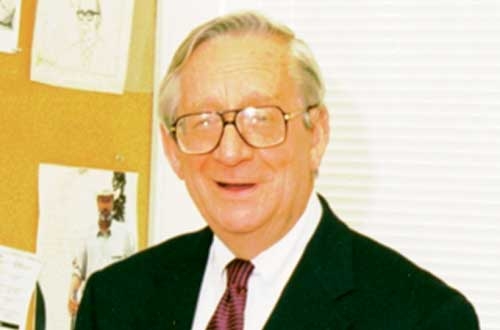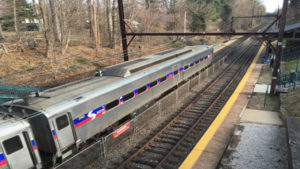Railway Age’s Luther Miller retires after nearly 60 years with publication
Written by William C. Vantuono, Editor-In-Chief, Railway Age
After nearly 60 years with Railway Age, and at the age of 88, Senior Consulting Editor Luther Sigsbee Miller has retired from Simmons-Boardman Publishing Corp.
Regarded as “the dean of American transportation journalists,” Luther came to Railway Age in February 1958 from The Institute for Railway Progress in Washington, D.C. For most of the next 57 years, his words, as well as those of numerous colleagues, served to chronicle an industry that changed and grew, and that today is flourishing. Suffice to say that Luther’s main legacy is a standard of excellence to which most journalists should aspire.
Luther and I worked side by side for nearly 23 years, he and the late Robert G. Lewis having hired me as Assistant Editor of Railway Age in July 1992. When I came to the publication, I knew the railway industry, and I knew, pretty much, how to report, write and edit. But it was Luther who taught me journalism, who worked with me to develop my skills. He also taught me the value of brevity, which is why I will leave the remainder of this tribute to three of our long-time Railway Age contributing editors: Frank N. Wilner, Lawrence H Kaufman, and Roy H. Blanchard.
—William C. Vantuono, Editor-in-Chief, Railway Age
“A legacy in railroad journalism”
Had novelist Jack Kerouac taken his “On the Road” characters Sal Paradise and Dean Moriarty on yet another recollection provoking road trip, they might have logged an exploration from North Carolina’s Outer Banks to Chapel Hill and Charlotte, a flirtation with London, and wrapped it up in New York. An appropriate third surveyor would have been Luther S. Miller.
Kerouac didn’t. Miller did. Start with the Outer Banks—that once desolate 200-mile-long collection of barrier islands that attracted the Wright Brothers to Kitty Hawk, and, well before that, English settlers and their first New World-born child, Virginia Dare. Of that self-reliant stock, some of whom clung to the Elizabethan English of Shakespeare, came Miller, at Avon, N.C., on Nov. 1, 1926—prophetically, now National Authors’ Day.
Today’s Outer Banks summon thoughts of plentiful beer and oysters at Awful Arthur’s. Avon, well south of the Kill Devil Hills party life, remains a rural sand-blanketed outpost of still fewer than 800 souls.
Paring Miller—curiously allergic to shellfish—away from sea-washed Avon, was the University of North Carolina’s world-class journalism school at Chapel Hill. Charlotte was barely of modern city status in 1948, but it afforded Miller his first post-college bylines, albeit at the cost of ear-splitting expletive-laced tutelage spewed by that era’s oft ne’er-do-well but talented, crusty newspaper editors.
Horace Greeley recommended, “Go west, young man.” Miller, following a Korean War U.S. Army stint, went east in 1953—to the talent-crib of so many dozen English authors for a year’s study at the London School of Economics. Among lessons learned: Avoid U.S. customs duty on a frightfully expensive new Burberry trench coat—once de rigueur for metropolitan journalists—by rolling about in it in the mud prior to returning home.
Erudite, urbane and ambitious—author Thomas Wolfe’s “You Can’t Go Home Again” echoing raucously—Miller took up residence in New York, prudently finding a rent-controlled flat to which he cleaved until recently. With journalism in his blood, economics in his brain and his now late-wife Mary in his heart, Miller carved a career, set a standard of excellence and established a legacy in railroad journalism that should and will reverberate, be taught, learned by a few, duplicated by fewer and celebrated by many.
His personality, vocabulary and wit is such that had his New York years begun a few decades earlier, Miller would have earned a seat beside Franklin P. Adams, Heywood Broun and Dorothy Parker at their enchanted daily luncheon table at Manhattan’s Algonquin Hotel—coincidentally named for the Indian tribe that once trod the sands of Avon.
There are many fabled railroad chiefs who knew of and read Miller—Robert R. Young, Alfred E. Perlman, Edd H. Bailey, Louis W. Menk, W. Graham Claytor, L. Stanley Crane, Bill Brosnan and a score more.
Many of journalism’s elite burst from North Carolina: David Brinkley, Reese Cleghorn, Charles Kuralt, Jeff MacNelly, Vermont Royster and Tom Wicker. Add Luther S. Miller.
Damn old age, failing eyesight and limited mobility. Double damn any month that does not deliver, in Railway Age, the insight of Luther S. Miller.
—Frank N. Wilner
“A gentleman at all times”
Luther Miller is truly a renaissance man. For much of the last half-century, he was the dean of railroad writers. A courtly North Carolinian, Mr. Miller could and did tell stories that kept his small audiences enthralled. He was a gentleman at all times.
As a young journalist at Business Week, I was introduced to Luther Miller by the late Brenton Welling, himself the then-dean of transportation writers, BW’s transportation editor and my mentor. Being a reporter/writer in New York in the 1960s was an exciting time, and having a drink with the likes of Luther Miller was a privilege.
During much of Luther’s tenure at Railway Age magazine, the publication engaged in a competitive battle with two other publications, Modern Railroads and Progressive Railroading, that specialized in telling their readers what was happening in the railroad world. The North American railroad press is down to just two main publications now (not including Railway Track & Structures, the speciality engineering magazine published by Simmons-Boardman), and Railway Age is one of the survivors. For that lofty state of affairs, Luther Miller deserves much of the credit.
Luther’s days of an after-hours drink and story telling session are winding down. I’m confident that he remembers the stories as though hearing them for the first time. I still remember being a guest at Luther’s upper Manhattan apartment for a Sunday brunch. It was like having an eighth day that week.
—Lawrence H Kaufman
“The writing process as an art form”
Luther Miller is the consummate gentleman with a quick wit, a keen appreciation for the well-turned phrase and a finely tuned ability to put one at ease. We came to know each other in the mid 1970s through Railway Age Publisher Bob Lewis, whom I had met on one of the famous mid-1960s Reading Railroad “Iron Horse Rambles.”
In the 1980s Luther started using some of my photos to illustrate Railway Age articles. Then in 1990 he invited me to write a monthly column about the newly expanding short line railroad business. He had watched as new short lines sprang up in his Native North Carolina and had spread throughout the south and elsewhere. He saw an opportunity to make Railway Age the railway magazine publishing industry’s leader in all short line matters.
He wanted a monthly short line column called the Marketing Advocate that touched on the challenges short lines faced in building a business and gave examples of successes. Our first effort was “The Taking of Car 12723,” and it ran in September 1991. It was a cautionary tale of what happens when too many railroads are involved in a move, each with their own priorities and how to fix the process. The series ran for more than ten years, and Luther gets credit for keeping me on track (literally), to the point and factual.
Luther sees the writing process as an art form: Tell them what you’re going to tell them, tell them, then tell them what you told them. He insists that the writer craft a bridge or “hook” between the introduction and the main event, and toward the end summarize the tale and slide seamlessly into the conclusion. He leads by example, always delighting in what he calls “wordsmanship,” and crafting some of the most eloquent railroad writing I’ve ever seen.
As to wordcraft itself, Luther is a stickler for punctuation. He says a comma is where you stop for breath or to let a point sink in. He is a firm believer in the Oxford comma to tell where lists begin and end, and in using semicolons to break up long lists. And, says he, spicing up the copy through clever alliteration helps to make reading an article a pleasure, even evoking a smile on occasion. Tools of the craft, if you will.
Luther maintains that the writer must always read every finished piece aloud to oneself. The reason, says he, is to make the copy flow. Not only must one set the scene for the reader, but give the reader a reason for going on, having made reading the story a pleasure, and having provided a clear take-away. We scribblers could do a lot worse than having Luther Miller parsing our every word. The business could really use more Luthers.
—Roy H. Blanchard





